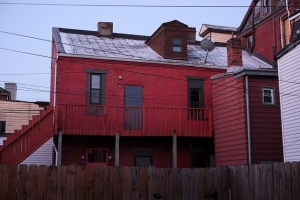Support migrant centric journalism today and donate

By Alex Owen
The US is famously a country of migrants. In olden days, they would arrive by ship at the port of New York. One of the most famous images of New York in about 1900 is of immigrants from Europe queuing on Ellis Island in the shadow of the Statue of Liberty. There were no requirements that you should have a job or that you should invest in a US business. All that was required was that you had made it to New York. Once immigrants were processed, they were released to begin their new lives as equal citizens of the United States of America.
Ellis Island has been closed since 1954. Most immigrants in the US now arrive by plane. But while the journey to the US may be quicker today, the process of immigration is slower. A lot slower. The system is labyrinthine and moves, sometimes at about the pace that fingernails grow and sometimes quite a lot slower than that.
Thousands of people now have to wait 20 years or more to have their application for permanent residence (or a green card, as it is known) decided. After they have a green card, they will have to apply for citizenship. The Washington Post reported recently on the case of a brother and sister from the Philippines who have been waiting for 24 years. - So far.
Some areas where system works
There are some areas where the system works; for example, senior managers wanting to work in the US can have their applications decided in a few months. The processing of marriage visas too is comparatively quick.Over all though, the system is slow. And not only is it slow, it is also infinitely complex. There is no one 'queue' (or 'line' as the Americans would call it) for immigration. There are many different lines moving at different speeds. What line you are in will depend on why it is you came to the US and how fast you will move towards citizenship will depend upon what country you come from.
In the 1960s, Congress decided to reform the US immigration system. It was feared that immigrants from some countries were facing discrimination in their applications for citizenship and so Congress contrived a new system of country quotas to ensure that people from all countries stood an equal chance of gaining citizenship. Nowadays, in any immigration category, no more than 7% of the green cards granted in any one year can be granted to applicants from any one country.
Unfortunate consequences
This system had a laudable goal but it has had unfortunate consequences. Because while all countries can receive only 7% of the total quota of green cards for each visa category, in any year, many more than 7% of the total number of applicants come from some countries and many fewer come from others, as you would expect. After all, not all countries are the same size.As a result there are many more applicants from some countries each year than can get green cards in many categories. Applicants from these countries have to be kept in a kind of holding pen until a free visa becomes available. Consequently, applicants from India, China, the Philippines and Mexico have to wait for extremely long periods before their permanent residence or citizenship applications are decided.
But so complex is the system that not all Indians and Chinese people have to wait in the same line or for the same amount of time. How long each applicant will have to wait will depend also on which type of green card he or she is applying for.
Three main categories
Under the US immigration system, green cards and citizenship are also split into three main categories;• family sponsored applicant
• employment-based applicants and
• asylum based applicants,
Each of these categories are split into sub-categories and each of these sub-categories has its own annual quota. Each of these quotas is subject to the 7% country cap. Consequently, the amount of time that an applicant will have to wait will vary. Mexicans and Filipinos in particular have to wait for the longest because so many of them have applied for some categories. US Citizenship and Immigration Services (US CIS) are currently considering green card applications made in January 2006 for citizens of most countries including Indians and Chinese citizens. However, it is considering applications from July 1993 (20 years ago) from Mexicans and in March 1996 (17 years ago) from Filipinos.
The family category has five sub-categories;
• IR: Immediate relative of US citizens (husbands and wives, minor children and parents) There is no numerical limit on these applicants.
• F1: unmarried partners, same sex partners and children over 21 of US citizens. 23,400 F1 green cards can be issued each year. There is a waiting list of 7-18 years depending on what country the applicants come from.
• F2A: Immediate relatives (As defined above) of green card holders. 87,934 F2A green cards can be granted each year. There is a waiting list of 4 years.
• F2B: unmarried partners, same sex partners and children over 21 of green card holders. 26,266 F2B visas can be issued each year. There is a waiting list of 10-15 years.
• F3: Married sons and daughters of US citizens. (Cap 23,400. Waiting list 10-19 years)
• F4: Brothers and sisters of adult US citizens (cap 65,000. Waiting list 15-25 years)
Employment-based green cards are also divided into various groups.
• EB-1: Priority workers. These are generally foreign workers with extraordinary ability in the arts and sciences, sport or academics or senior managers and executives. There is a cap of 41,455 such visas each year which is often not reached.
• EB-2: Professionals with advanced degrees or exceptional ability in the sciences, arts or business. (cap 41,455, no waiting list)
• EB-3 Skilled workers (cap 41,455, waiting list 6 years minimum though this will vary from country to country. Applicants from India and China in particular have to wait for the longest)
• EB-4 Special immigrants (including ministers, religious workers, etc) (Cap 10,291, not reached)
• EB-5 Investors (Cap 10,291, not reached)
There are also green cards granted to those claiming political asylum. There is no cap on these green cards.
70,000 green cards are granted annually to refugees. There are also 50,000 green cards given out each year in the diversity immigrant visa program or green card lottery.
Queues are 'a measure of success'
In some ways, the massive queues are a measure of success. The US is a very popular place to live. Over the last decade, US CIS has created 6.6m naturalised US citizens but the waiting list continues to grow.The delays in this system are not President Obama's fault. The waiting lists have built up over years but the sheer length of the lists could cause yet more problems for the President's immigration reform program.
President Obama has said that he fully intends to see reform of the US immigration system this year. Most people are agreed that it needs reform. The president has said that part of the comprehensive reform of the system that he intends to introduce will be the creation of a 'pathway to citizenship' for the estimated 11m illegal immigrants currently in the US.
Illegal immigrants will have to wait in line
However, this will create its own problems. The President is clear that illegal immigrants will have to wait for green cards until all those currently in the line have been dealt with. With a current wait of 20 years for legal Mexicans, one wonders how many of the illegal immigrants who apply for citizenship if the President's law is passed, will live long enough to achieve legal status.After all, if only 7% of those processed in any one year can be Mexicans, it could take hundreds of years before the last of them is dealt with.
If you would like to apply for a US visa, WorkPermit.com can help. WorkPermit.com is a specialist visa consultancy with over twenty years of experience dealing with visa applications. We can help with a wide range of visa applications to your country of choice. Please feel free to contact us for further details.





















